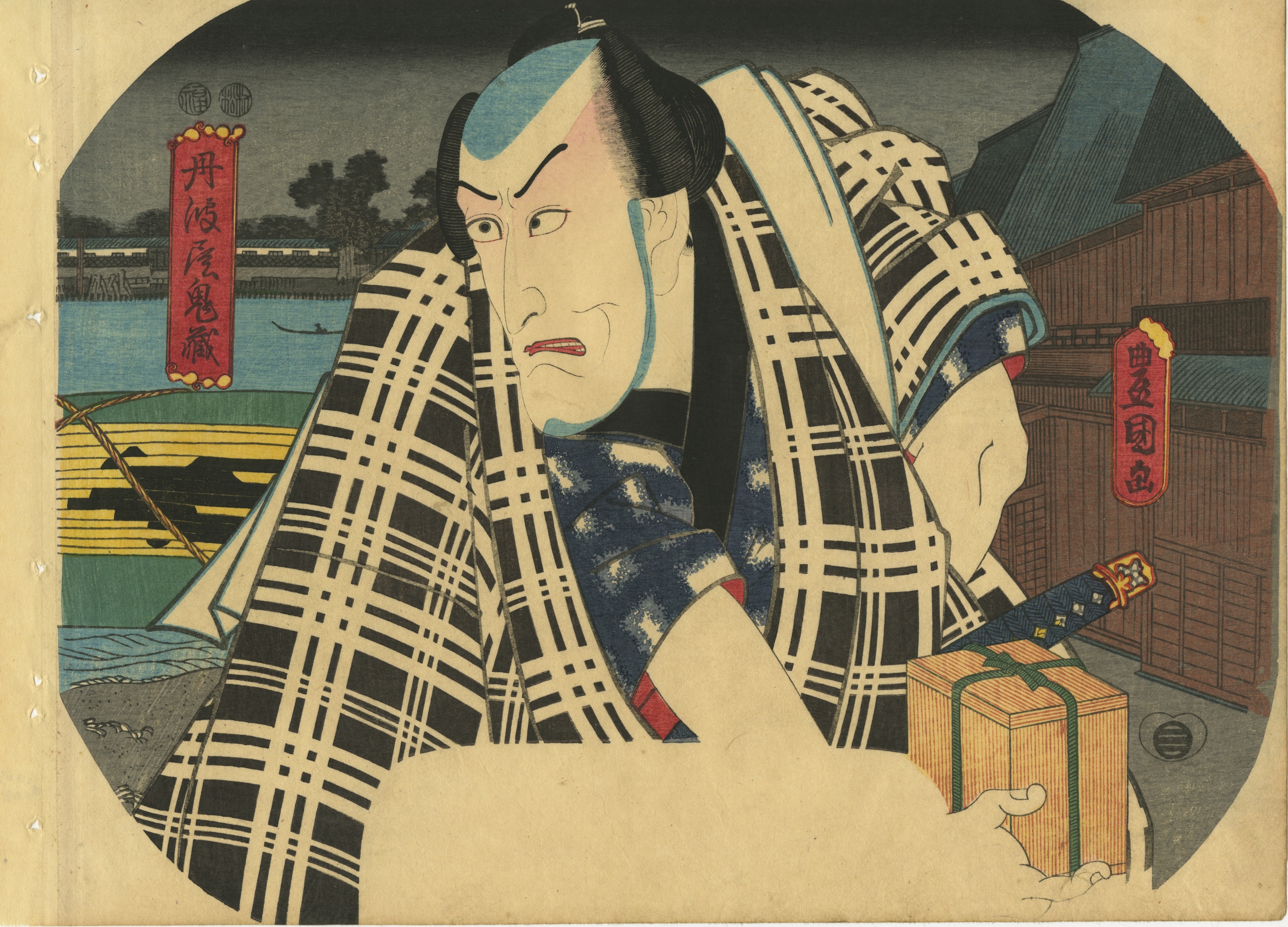Artist: Utagawa Kunisada [歌川 国貞] a.k.a. Utagawa Toyokuni III [三代歌川豊国] (Japanese, 1786 – 1865).
Signature: Kunisada ga [国貞画] in a red double-gourd cartouche.
Publisher: Ibaya Senzaburō [伊場屋仙三郎] (Japanese, fl. c. 1815 – 1869); seal: san (三) in a circle to verso.
Date seal: Hebi (巳, Snake), Tenpō 4 , 1833, to verso.
Censor seal: kiwame (極, approved), to verso.
Media: Double-side fan print (uchiwa-e); 225 x 283 mm.
Series: Tosei rok’kasen or
Tosei rokkasen [當世六花撰] – two translations: (1) by Sebastian Izzard: Six choice modern flowers, (2) by Horst Graebner: Modern Six [Immortal] Poets.
Character: Sawamura Tosshō I [沢村訥升] (Japanese, 1802 – 1853); other names:
Sawamura Gennosuke II, Suketakaya Takasuke III, Sawamura Chōjūrō V, Sawamura Sōjūrō V, Sawamura Genpei I, Sawamura Tosshi V;
Poetry names: Kōga, Tosshi V, Tosshō;
Guild: Kinokuniya.
Poet: Ariwara Narihira [在原業平] (Japanese, 825 – 9 July 880) – one of
Six Immortal Poets (
六歌仙,
rokkasen)
A double-sheet uncut fan print featuring a half-length, three-quarter view, turned to the right portrait of Kabuki actor Sawamura Tosshō I. He holds a bow (yumi, 弓) and an arrow (ya, 矢) in his left hand, while his right hand grasps the collar of his under-kimono, with his thumb tucked inside. He wears a blue outer kimono patterned with a woven lattice motif, lined with red and yellow on the sleeves. Beneath it, his red under-kimono with a black collar is visible. A white towel (tenugui, 手拭い) is draped around his neck and shoulder.
A red scroll with an inscription hangs behind him, reading: Ariwara Narihira (在原業平); Sawamura Tosshō I (沢村訥升). His name is written with kanji, hentaigana, and hiragana: Kinokuniya Tosshō (きの國やとし志ょう)—his guild and poetry names. The series title Tōsei Rokkasen (当世六歌撰) appears in the red cartouche to the left, and the artist’s signature is in the double-gourd red cartouche to the right. The background features a blue and yellow gradient decorated with floral roundels.
The reverse side features a decorative design with floral roundels in blue and green. A paper slip (tanzaku, 短冊) with a red cloud-like gradient at the edges is positioned diagonally across the composition. It contains a calligraphic inscription in cursive script. Three standard seals—publisher, approval, and date—are in the bottom right quadrant of the print.
Ref: (1) [
LIB-2967.2022] Utagawa Kunisada (1786 – 1865): His world revisited / Catalogue № 17, Exhibition March 17-21, 2021. — NY: Sebastian Izzard, LLC., 2021; p. 130-1. (2) [
LIB-1212.2017] Robert Schaap. Kunisada: Imaging, drama and beauty. — Leiden: Hotei Publishing, 2016, p. 58.
[With tremendous help from Horst Graebner of Kunisada Project].
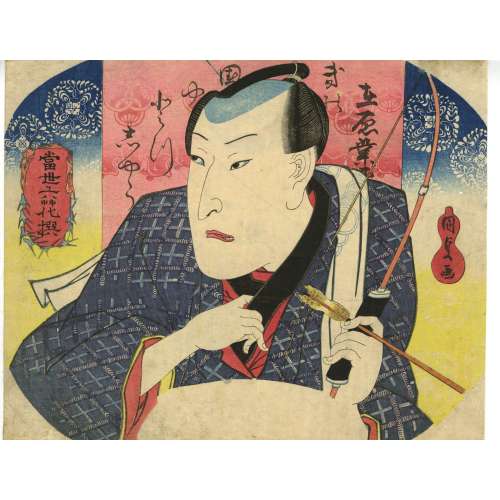 NEWArtist: Utagawa Kunisada [歌川 国貞] a.k.a. Utagawa Toyokuni III [三代歌川豊国] (Japanese, 1786 – 1865). Signature: Kunisada ga [国貞画] in a red double-gourd cartouche. Publisher: Ibaya Senzaburō [伊場屋仙三郎] (Japanese, fl. c. 1815 – 1869); seal: san (三) in a circle to verso. Date seal: Hebi (巳, Snake), Tenpō 4 , 1833, to verso. Censor seal: kiwame (極, approved), to verso. Media: Double-side fan print (uchiwa-e); 225 x 283 mm. Series: Tosei rok’kasen or Tosei rokkasen [當世六花撰] – two translations: (1) by Sebastian Izzard: Six choice modern flowers, (2) by Horst Graebner: Modern Six [Immortal] Poets. Character: Sawamura Tosshō I [沢村訥升] (Japanese, 1802 – 1853); other names: Sawamura Gennosuke II, Suketakaya Takasuke III, Sawamura Chōjūrō V, Sawamura Sōjūrō V, Sawamura Genpei I, Sawamura Tosshi V; Poetry names: Kōga, Tosshi V, Tosshō; Guild: Kinokuniya. Poet: Ariwara Narihira [在原業平] (Japanese, 825 – 9 July 880) – one of Six Immortal Poets (六歌仙, rokkasen) A double-sheet uncut fan print featuring a half-length, three-quarter view, turned to the right portrait of Kabuki actor Sawamura Tosshō I. He holds a bow (yumi, 弓) and an arrow (ya, 矢) in his left hand, while his right hand grasps the collar of his under-kimono, with his thumb tucked inside. He wears a blue outer kimono patterned with a woven lattice motif, lined with red and yellow on the sleeves. Beneath it, his red under-kimono with a black collar is visible. A white towel (tenugui, 手拭い) is draped around his neck and shoulder. A red scroll with an inscription hangs behind him, reading: Ariwara Narihira (在原業平); Sawamura Tosshō I (沢村訥升). His name is written with kanji, hentaigana, and hiragana: Kinokuniya Tosshō (きの國やとし志ょう)—his guild and poetry names. The series title Tōsei Rokkasen (当世六歌撰) appears in the red cartouche to the left, and the artist’s signature is in the double-gourd red cartouche to the right. The background features a blue and yellow gradient decorated with floral roundels. The reverse side features a decorative design with floral roundels in blue and green. A paper slip (tanzaku, 短冊) with a red cloud-like gradient at the edges is positioned diagonally across the composition. It contains a calligraphic inscription in cursive script. Three standard seals—publisher, approval, and date—are in the bottom right quadrant of the print. Ref: (1) [LIB-2967.2022] Utagawa Kunisada (1786 – 1865): His world revisited / Catalogue № 17, Exhibition March 17-21, 2021. — NY: Sebastian Izzard, LLC., 2021; p. 130-1. (2) [LIB-1212.2017] Robert Schaap. Kunisada: Imaging, drama and beauty. — Leiden: Hotei Publishing, 2016, p. 58. [With tremendous help from Horst Graebner of Kunisada Project].
NEWArtist: Utagawa Kunisada [歌川 国貞] a.k.a. Utagawa Toyokuni III [三代歌川豊国] (Japanese, 1786 – 1865). Signature: Kunisada ga [国貞画] in a red double-gourd cartouche. Publisher: Ibaya Senzaburō [伊場屋仙三郎] (Japanese, fl. c. 1815 – 1869); seal: san (三) in a circle to verso. Date seal: Hebi (巳, Snake), Tenpō 4 , 1833, to verso. Censor seal: kiwame (極, approved), to verso. Media: Double-side fan print (uchiwa-e); 225 x 283 mm. Series: Tosei rok’kasen or Tosei rokkasen [當世六花撰] – two translations: (1) by Sebastian Izzard: Six choice modern flowers, (2) by Horst Graebner: Modern Six [Immortal] Poets. Character: Sawamura Tosshō I [沢村訥升] (Japanese, 1802 – 1853); other names: Sawamura Gennosuke II, Suketakaya Takasuke III, Sawamura Chōjūrō V, Sawamura Sōjūrō V, Sawamura Genpei I, Sawamura Tosshi V; Poetry names: Kōga, Tosshi V, Tosshō; Guild: Kinokuniya. Poet: Ariwara Narihira [在原業平] (Japanese, 825 – 9 July 880) – one of Six Immortal Poets (六歌仙, rokkasen) A double-sheet uncut fan print featuring a half-length, three-quarter view, turned to the right portrait of Kabuki actor Sawamura Tosshō I. He holds a bow (yumi, 弓) and an arrow (ya, 矢) in his left hand, while his right hand grasps the collar of his under-kimono, with his thumb tucked inside. He wears a blue outer kimono patterned with a woven lattice motif, lined with red and yellow on the sleeves. Beneath it, his red under-kimono with a black collar is visible. A white towel (tenugui, 手拭い) is draped around his neck and shoulder. A red scroll with an inscription hangs behind him, reading: Ariwara Narihira (在原業平); Sawamura Tosshō I (沢村訥升). His name is written with kanji, hentaigana, and hiragana: Kinokuniya Tosshō (きの國やとし志ょう)—his guild and poetry names. The series title Tōsei Rokkasen (当世六歌撰) appears in the red cartouche to the left, and the artist’s signature is in the double-gourd red cartouche to the right. The background features a blue and yellow gradient decorated with floral roundels. The reverse side features a decorative design with floral roundels in blue and green. A paper slip (tanzaku, 短冊) with a red cloud-like gradient at the edges is positioned diagonally across the composition. It contains a calligraphic inscription in cursive script. Three standard seals—publisher, approval, and date—are in the bottom right quadrant of the print. Ref: (1) [LIB-2967.2022] Utagawa Kunisada (1786 – 1865): His world revisited / Catalogue № 17, Exhibition March 17-21, 2021. — NY: Sebastian Izzard, LLC., 2021; p. 130-1. (2) [LIB-1212.2017] Robert Schaap. Kunisada: Imaging, drama and beauty. — Leiden: Hotei Publishing, 2016, p. 58. [With tremendous help from Horst Graebner of Kunisada Project].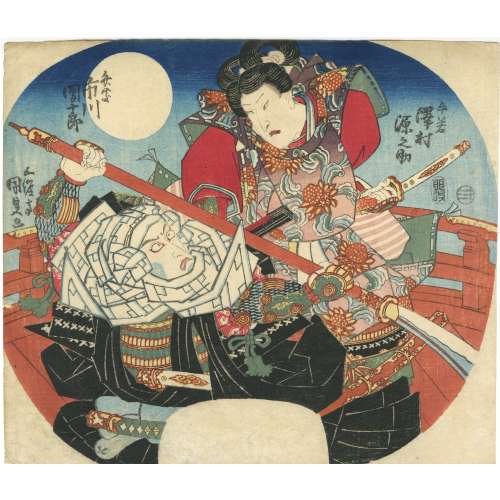 Sawamura Gennosuke II [沢村源之助] (Suketakaya Takasuke III, Sawamura Chōjūrō V, Sawamura Sōjūrō V, Sawamura Tosshō I, Sawamura Genpei I, Japanese, 1802/7 – 1853) as Ushiwakamaru [牛若丸], a.k.a. Minamoto no Yoshitsune [源 義経]. Ichikawa Danjūrō VII [市川団十郎] (Ichikawa Ebizō V, Ichikawa Hakuen II, Ichikawa Shinnosuke I, Japanese, 1791 – 1859) as Benkei, a.k.a. Saitō Musashibō Benkei [西塔武蔵坊弁慶] (Japanese, 1155 – 1189) Performance: Grand finale dance play [大切所作事] (ōgiri shosagoto) at Soga Festival - A Composite Piece of Musashi「曽我祭武蔵摂物 ごさいれいむさしのひきもの)」 (Gosairei Musashi no hikimono), performed at Kawarazakiza (河原崎座) in 05/1831 (See kabuki plays from 1831). Soga Festival (Soga Matsuri) is an annual theatre event in Edo (Tokyo). Scene: The Fight on Gojo Bridge or Benkei on the Bridge [橋弁慶] (Hashi Benkei). The story relates how Benkei, first a monk, then a mountain ascetic, and then a rogue warrior, a man of Herculean strength, was subdued by the young Onzoshi Ushiwaka Maru (Yoshitsune) on Gojo Bridge. Benkei wandered around Kyoto with the intention of relieving 1000 samurai of their swords. One night, with one more sword to go, he saw Yoshitsune playing the flute and wearing a golden sword at the Gojotenjin Shrine. They agreed to fight on Gojo Bridge in southern Kyoto. However, Yoshitsune was too agile for Benkei and had been educated in the secrets of fighting by the tengu. Following Yoshitsune’s victory, Benkei became Yoshitsune’s retainer. Artist: Utagawa Kunisada [歌川 国貞], a.k.a. Toyokuni III (Japanese, 1786 – 1865). Publisher: Ibaya Senzaburo [伊場屋仙三郎]. Signed: Gototei Kunisada ga [五渡亭国貞画]. Date-aratame seal: Tenpō 2 (1831). Size: Fan print (uchiwa-e). Ref.: (1) Tokyo Metropolitan Library, 請求記号 M339-6/東M339-006. (2) Ritsumeikan University, Art Research Center, Portal Database M339-006(02).
Sawamura Gennosuke II [沢村源之助] (Suketakaya Takasuke III, Sawamura Chōjūrō V, Sawamura Sōjūrō V, Sawamura Tosshō I, Sawamura Genpei I, Japanese, 1802/7 – 1853) as Ushiwakamaru [牛若丸], a.k.a. Minamoto no Yoshitsune [源 義経]. Ichikawa Danjūrō VII [市川団十郎] (Ichikawa Ebizō V, Ichikawa Hakuen II, Ichikawa Shinnosuke I, Japanese, 1791 – 1859) as Benkei, a.k.a. Saitō Musashibō Benkei [西塔武蔵坊弁慶] (Japanese, 1155 – 1189) Performance: Grand finale dance play [大切所作事] (ōgiri shosagoto) at Soga Festival - A Composite Piece of Musashi「曽我祭武蔵摂物 ごさいれいむさしのひきもの)」 (Gosairei Musashi no hikimono), performed at Kawarazakiza (河原崎座) in 05/1831 (See kabuki plays from 1831). Soga Festival (Soga Matsuri) is an annual theatre event in Edo (Tokyo). Scene: The Fight on Gojo Bridge or Benkei on the Bridge [橋弁慶] (Hashi Benkei). The story relates how Benkei, first a monk, then a mountain ascetic, and then a rogue warrior, a man of Herculean strength, was subdued by the young Onzoshi Ushiwaka Maru (Yoshitsune) on Gojo Bridge. Benkei wandered around Kyoto with the intention of relieving 1000 samurai of their swords. One night, with one more sword to go, he saw Yoshitsune playing the flute and wearing a golden sword at the Gojotenjin Shrine. They agreed to fight on Gojo Bridge in southern Kyoto. However, Yoshitsune was too agile for Benkei and had been educated in the secrets of fighting by the tengu. Following Yoshitsune’s victory, Benkei became Yoshitsune’s retainer. Artist: Utagawa Kunisada [歌川 国貞], a.k.a. Toyokuni III (Japanese, 1786 – 1865). Publisher: Ibaya Senzaburo [伊場屋仙三郎]. Signed: Gototei Kunisada ga [五渡亭国貞画]. Date-aratame seal: Tenpō 2 (1831). Size: Fan print (uchiwa-e). Ref.: (1) Tokyo Metropolitan Library, 請求記号 M339-6/東M339-006. (2) Ritsumeikan University, Art Research Center, Portal Database M339-006(02).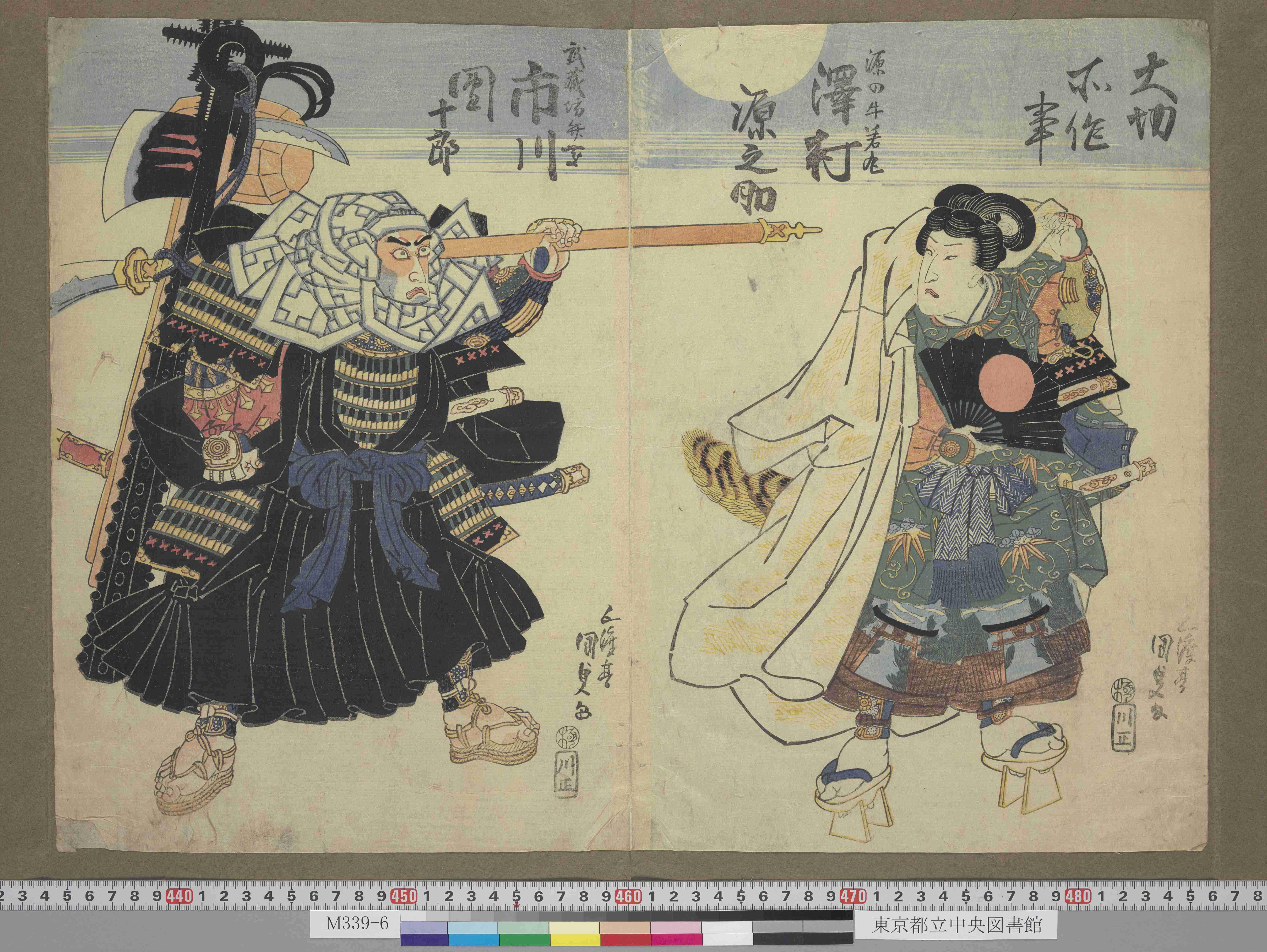
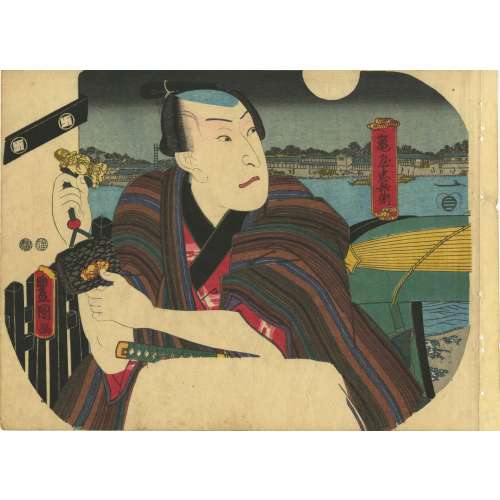 Artist: Utagawa Kunisada [歌川 国貞] a.k.a. Utagawa Toyokuni III [三代歌川豊国] (Japanese, 1786 – 1865). Signed: Toyokuni ga [豊国 画] in a red toshidama cartouche. Actor: Sawamura Gennosuke II [沢村源之助] (Japanese, 1802/7 – 1853); other names: Suketakaya Takasuke III, Sawamura Chōjūrō V [沢村長十郎], Sawamura Tosshō I, Sawamura Genpei I. Character: Kameya Chubei [亀屋忠兵衛] Play: Koi Bikyaku Yamato Orai [恋飛脚大和往来] Performance: Kawarasaki Theatre [河原崎座] in the 2nd month of 1851. Double nanushi censor seals: Fuku & Muramatsu, from 3rd month of Kaei 2 to 11th month of Kaei 4 (1849-51). Another fan print from the pair SVJP-0212-1.2016: Ichikawa Ebizō V as Tanbaya Onizo / Fan print, 1851.
Artist: Utagawa Kunisada [歌川 国貞] a.k.a. Utagawa Toyokuni III [三代歌川豊国] (Japanese, 1786 – 1865). Signed: Toyokuni ga [豊国 画] in a red toshidama cartouche. Actor: Sawamura Gennosuke II [沢村源之助] (Japanese, 1802/7 – 1853); other names: Suketakaya Takasuke III, Sawamura Chōjūrō V [沢村長十郎], Sawamura Tosshō I, Sawamura Genpei I. Character: Kameya Chubei [亀屋忠兵衛] Play: Koi Bikyaku Yamato Orai [恋飛脚大和往来] Performance: Kawarasaki Theatre [河原崎座] in the 2nd month of 1851. Double nanushi censor seals: Fuku & Muramatsu, from 3rd month of Kaei 2 to 11th month of Kaei 4 (1849-51). Another fan print from the pair SVJP-0212-1.2016: Ichikawa Ebizō V as Tanbaya Onizo / Fan print, 1851.